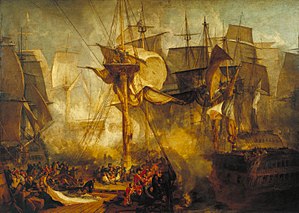From Wikipedia, the free encyclopedia
| Battle of Trafalgar |
|---|
| Part of the Trafalgar Campaign | 
The Battle of Trafalgar, as seen from the mizzen
starboard shrouds of the Victory
by J. M. W. Turner (oil on canvas, 1806 to 1808) | | | Belligerents |
|---|
 United Kingdom United Kingdom |  France France
 Spain Spain | | Commanders |
|---|
 Horatio Nelson, 1st Viscount Nelson † Horatio Nelson, 1st Viscount Nelson † |  Pierre de Villeneuve # Pierre de Villeneuve #
 Federico Gravina Federico Gravina | | Strength |
|---|
| 27 ships of the line and 6 others. | France: 18 ships of the line and 8 others. Spain: 15 ships of the line | | Casualties and losses |
|---|
458 killed
1,208 wounded
1,666 total[1] | 7,000 captured,
21 ships captured,
1 ship destroyedFrance: 2,218 dead,
1,155 wounded Spain: 1,025 dead,
1,383 wounded
Total: 12,781
|
|
|
|
The Battle of Trafalgar (21 October 1805) was a sea battle fought between the British Royal Navy and the combined fleets of the French Navy and Spanish Navy, during the War of the Third Coalition (August–December 1805) of the Napoleonic Wars (1803–1815). The battle was the most decisive British naval victory of the war. Twenty-seven British ships of the line led by Admiral Lord Nelson aboard HMS Victory defeated thirty-three French and Spanish ships of the line under French Admiral Pierre Villeneuve off the south-west coast of Spain, just west of Cape Trafalgar. The Franco-Spanish fleet lost twenty-two ships, without a single British vessel being lost.
The British victory spectacularly confirmed the naval supremacy that Britain had established during the past century and was achieved in part through Nelson's departure from the prevailing naval tactical orthodoxy, which involved engaging an enemy fleet in a single line of battle parallel to the enemy to facilitate signalling in battle and disengagement, and to maximize fields of fire and target areas. Nelson instead divided his smaller force into two columns directed perpendicularly against the larger enemy fleet, with decisive results.
Nelson was mortally wounded during the battle, becoming Britain's greatest war hero. The commander of the joint French and Spanish forces, AdmiralPierre de Villeneuve, was captured along with his ship Bucentaure. Spanish Admiral Federico Gravina escaped with the remnant of the fleet, and succumbed months later to wounds he sustained during the battle.
